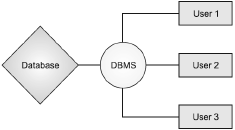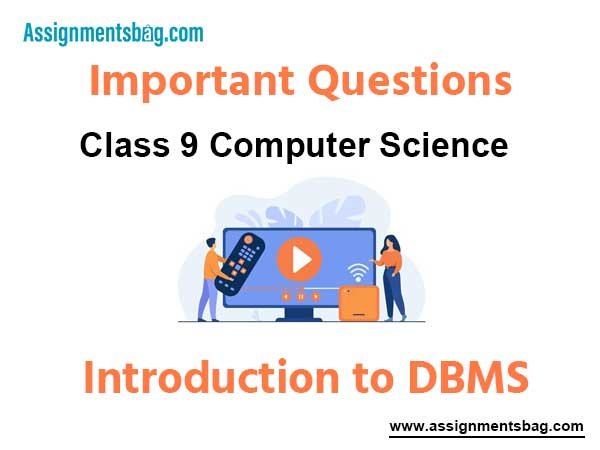Please refer to Introduction to DBMS Class 9 Computer Science Important Questions with solutions provided below. These questions and answers have been provided for Class 9 Computer Science based on the latest syllabus and examination guidelines issued by CBSE, NCERT, and KVS. Students should learn these problem solutions as it will help them to gain more marks in examinations. We have provided Important Questions for Class 9 Computer Science for all chapters in your book. These Board exam questions have been designed by expert teachers of Standard 9.
Class 9 Computer Science Important Questions Introduction to DBMS
Short Answer Type Questions:
Question: What is database?
Ans: Collection of interrelated data is called database. Data is in the organized form in the database. User can obtain the required information from the database. A Software is used to prepare the database which is called the Database Management System.
Question: What are the different types of relationships?
Ans: Different types of relations are given below:
1. One to One relationship
2. One to Many relationship
3. Many to many relationship
Question: Write the names of different DBA’s?
Ans: Name of different DBA’s are given below:
1. Administrative DBA
2. Development DBA
3. Architect DBA
4. Data Warehouse DBA
Question: What is SQL?
Ans: Full name of SQL is Structured Query Language. It is a High-Level Language which is used in the Relational Database Management Systems (RDBMS). It can be used to store, control and editing of data in the database. It is based on the concept that which data is needed by a programmer.
Question: Name the different types of keys?
Ans: Keys are the important part of the database management system. These are of many types. Some of the common types of keys are given below:
1. Super Key
2. Candidate Key
3. Primary Key
4. Composite Key
5. Foreign Key
Long Answer Type Questions:
Question: Describe Normalization. How many types of Normalization?
Ans: Normalization is a systematic and scientific approach for converting a complex table into a userfriendly form. It can be used to reduce redundancy in a table. It is also used to reduce or eliminate database inconsistency. Methods of implementing normalization are called Normal Forms. These methods of normalization are as follows.
1. The first normal form
2. The second normal form
3. The third normal form
4. The fourth normal form
5. Fifth normal form
Question: What do you mean by DBMS? Describe its advantages and disadvantages.
Ans: DBMS stands for Database Management System. This system is designed to address the shortcomings of file processing systems. It is a system software. It is used for database creation, data management, data recovery etc. DBMS works as an interface between the user and the database.

Advantages of DBMS:
1. DBMS Controls redundancy
2. Data can be shared between multiple users
3. DBMS Provides data backup facility
4. DBMS Provides data security
Disadvantages of DBMS:
1. Technical knowledge is required to use DBMS
2. The cost of DBMS and its management is high
3. More hardware is required for running DBMS
4. Working of DBMS is quite complicated
5. It is very difficult to move DBMS from one place to another
Question: What do you mean by data models? Write about its parts.
Ans: Data model is a way that helps us to present the information about the structure of the database. It is used for various purposes such as: to describe the data, the relationships between them, etc.
Parts of the data model:
Data models can be mainly divided into three parts which are as under:
• Object Oriented Logical Model: It is used to describe the data line-by-line. These are of mainly five types: Binary Model, Functional Model, Entity Relationship Model, Object Oriented Logical Model, Semantic Data Model.
• Record-based logical model: It is used to describe line-by-line data but it uses a consistent format to represent data. Each record has its own attributes. These are of mainly three types: Network Model, relational model, hierarchical model
• Physical data model: It is used to describe the lowest level of data. Entities, attributes, entity sets,relationship, relationship sets etc. are some of the important parts of this model.

